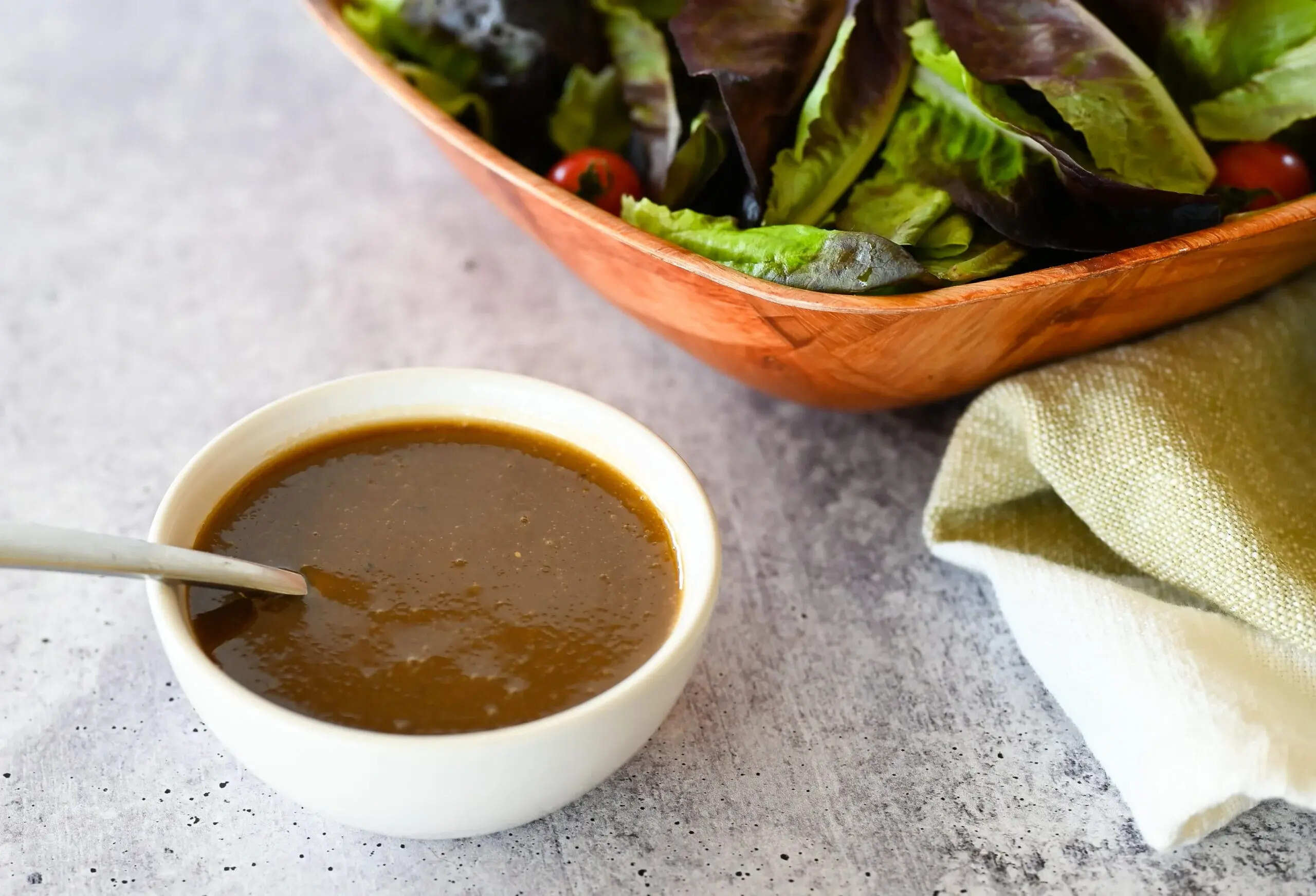This balsamic vinaigrette is a versatile and flavorful dressing that can elevate any salad. With its perfect balance of tangy balsamic vinegar and rich olive oil, it adds a gourmet touch to your greens. The addition of dijon mustard, garlic, and a hint of honey creates a harmonious blend that will make your taste buds dance.
If you don't usually keep dijon mustard or balsamic vinegar in your pantry, you might need to pick these up at the supermarket. Dijon mustard adds a subtle kick and helps emulsify the dressing, while balsamic vinegar provides a sweet and tangy flavor that is essential for this recipe.

Ingredients For Balsamic Vinaigrette Recipe
Extra-virgin olive oil: This high-quality oil is the base of the vinaigrette, providing a rich and smooth texture.
Balsamic vinegar: Adds a sweet and tangy flavor that is essential for the dressing.
Dijon mustard: Helps to emulsify the dressing and adds a subtle kick.
Garlic: Freshly minced garlic adds a robust flavor.
Honey: Balances the acidity of the vinegar with a touch of sweetness.
Salt and pepper: Enhances the overall flavor of the vinaigrette.
Technique Tip for This Vinaigrette
When making a vinaigrette, it's crucial to achieve a proper emulsion. To ensure the olive oil and balsamic vinegar blend seamlessly, start by whisking the vinegar mixture vigorously. Then, add the olive oil in a slow, steady stream while continuing to whisk. This gradual incorporation helps the oil and vinegar combine without separating, resulting in a smooth and cohesive dressing.
Suggested Side Dishes
Alternative Ingredients
extra-virgin olive oil - Substitute with avocado oil: Avocado oil has a similar healthy fat profile and a mild flavor that works well in vinaigrettes.
extra-virgin olive oil - Substitute with grapeseed oil: Grapeseed oil is neutral in flavor and has a light texture, making it a good alternative for dressings.
balsamic vinegar - Substitute with red wine vinegar: Red wine vinegar has a tangy flavor that can mimic the acidity of balsamic vinegar, though it lacks the sweetness.
balsamic vinegar - Substitute with apple cider vinegar: Apple cider vinegar provides a fruity acidity that can replace balsamic vinegar, especially when mixed with a bit of sweetener.
dijon mustard - Substitute with whole grain mustard: Whole grain mustard has a similar tangy flavor and can add a bit of texture to the vinaigrette.
dijon mustard - Substitute with yellow mustard: Yellow mustard is milder but can still provide the necessary tang and emulsifying properties.
garlic - Substitute with shallots: Minced shallots can provide a milder, slightly sweet onion flavor that complements vinaigrettes.
garlic - Substitute with garlic powder: Garlic powder can be used in place of fresh garlic for a more subtle garlic flavor.
honey - Substitute with maple syrup: Maple syrup offers a similar sweetness with a slightly different flavor profile that works well in dressings.
honey - Substitute with agave nectar: Agave nectar is a good alternative for a similar level of sweetness and consistency.
salt - Substitute with soy sauce: Soy sauce can add a salty and umami flavor, though it will also add a bit of color and a different depth of flavor.
pepper - Substitute with white pepper: White pepper provides a similar heat without the black specks, which can be preferable in some dressings.
Other Alternative Recipes Similar to This Vinaigrette
How to Store / Freeze This Vinaigrette
To keep your balsamic vinaigrette fresh, store it in an airtight container, such as a mason jar or a tightly sealed bottle. This prevents any unwanted flavors from seeping in and keeps the dressing at its best.
Place the container in the refrigerator. The cool temperature will help preserve the flavors and extend the shelf life of your vinaigrette.
Before each use, give the container a good shake. The ingredients may separate over time, but a quick shake will re-emulsify the dressing and bring it back to its original consistency.
If you notice the olive oil solidifying in the fridge, don't worry. Simply let the vinaigrette sit at room temperature for a few minutes before using, or run the container under warm water to liquefy the oil.
For longer storage, consider freezing the vinaigrette. Pour it into ice cube trays, freeze until solid, then transfer the cubes to a freezer-safe bag or container. This way, you can thaw just the amount you need for a salad or marinade.
When ready to use frozen vinaigrette, thaw it in the refrigerator overnight or at room temperature for a few hours. Give it a good shake or whisk to re-emulsify before serving.
Always check the vinaigrette for any off smells or changes in appearance before using, especially if it has been stored for an extended period. Freshness is key to enjoying the best flavors in your salads and dishes.
How to Reheat Leftovers
Gently warm the balsamic vinaigrette in a small saucepan over low heat. Stir occasionally to ensure even heating and prevent separation. This method preserves the delicate flavors of the olive oil and balsamic vinegar.
If you prefer a quicker method, microwave the vinaigrette in a microwave-safe bowl. Heat in short bursts of 10-15 seconds, stirring in between to maintain the emulsion and avoid overheating.
For a more controlled approach, place the vinaigrette in a heatproof bowl and set it over a pot of simmering water (double boiler method). Stir gently until warmed through. This technique ensures gentle, even heating without breaking the emulsion.
If you have a sous vide machine, place the vinaigrette in a sealed bag and immerse it in a water bath set to a low temperature (around 120°F or 49°C). This method keeps the vinaigrette at a consistent temperature, preserving its texture and flavor.
To add a touch of freshness, whisk in a small amount of freshly minced garlic or a splash of balsamic vinegar after reheating. This can revive the flavors and enhance the overall taste.
Best Tools for Making This Vinaigrette
Whisk: Essential for blending the ingredients smoothly and ensuring the dressing is well-emulsified.
Mixing bowl: Used to combine all the ingredients together.
Measuring cups: Necessary for accurately measuring the olive oil and balsamic vinegar.
Measuring spoons: Important for measuring the dijon mustard, honey, salt, and pepper.
Garlic press: Handy for mincing the garlic clove finely.
Cutting board: Provides a stable surface for mincing the garlic.
Chef's knife: Used for mincing the garlic clove.
Spatula: Useful for scraping down the sides of the mixing bowl to ensure all ingredients are incorporated.
How to Save Time on Making This Vinaigrette
Prepare ingredients in advance: Mince the garlic and measure out the olive oil, balsamic vinegar, and dijon mustard ahead of time.
Use a blender: Combine all ingredients in a blender and blend until emulsified, saving you the effort of whisking.
Make a large batch: Double or triple the recipe and store the extra vinaigrette in the fridge for up to a week.
Pre-mix dry ingredients: Mix the salt and pepper together in a small bowl so you can season quickly.

Balsamic Vinaigrette Recipe
Ingredients
Main Ingredients
- ½ cup Extra-virgin olive oil
- ¼ cup Balsamic vinegar
- 1 tablespoon Dijon mustard
- 1 clove Garlic, minced
- 1 teaspoon Honey
- to taste Salt and pepper
Instructions
- In a bowl, whisk together balsamic vinegar, Dijon mustard, minced garlic, and honey.
- Slowly drizzle in the olive oil while whisking continuously until the dressing is emulsified.
- Season with salt and pepper to taste.
Nutritional Value
Keywords
More Amazing Recipes to Try 🙂
- Custard Recipe30 Minutes
- Fresh Rhubarb Pie Recipe1 Hours 5 Minutes
- Indian Heeng Jeera Aloo Recipe30 Minutes
- Indian Lentil Stew Recipe1 Hours
- Indian Paneer Capsicum Sabzi Recipe35 Minutes
- Indian Chana Dal Fry Recipe45 Minutes
- Indian Dal Baati Churma Recipe1 Hours 30 Minutes
- Seven Layer Dip Recipe20 Minutes

Leave a Reply